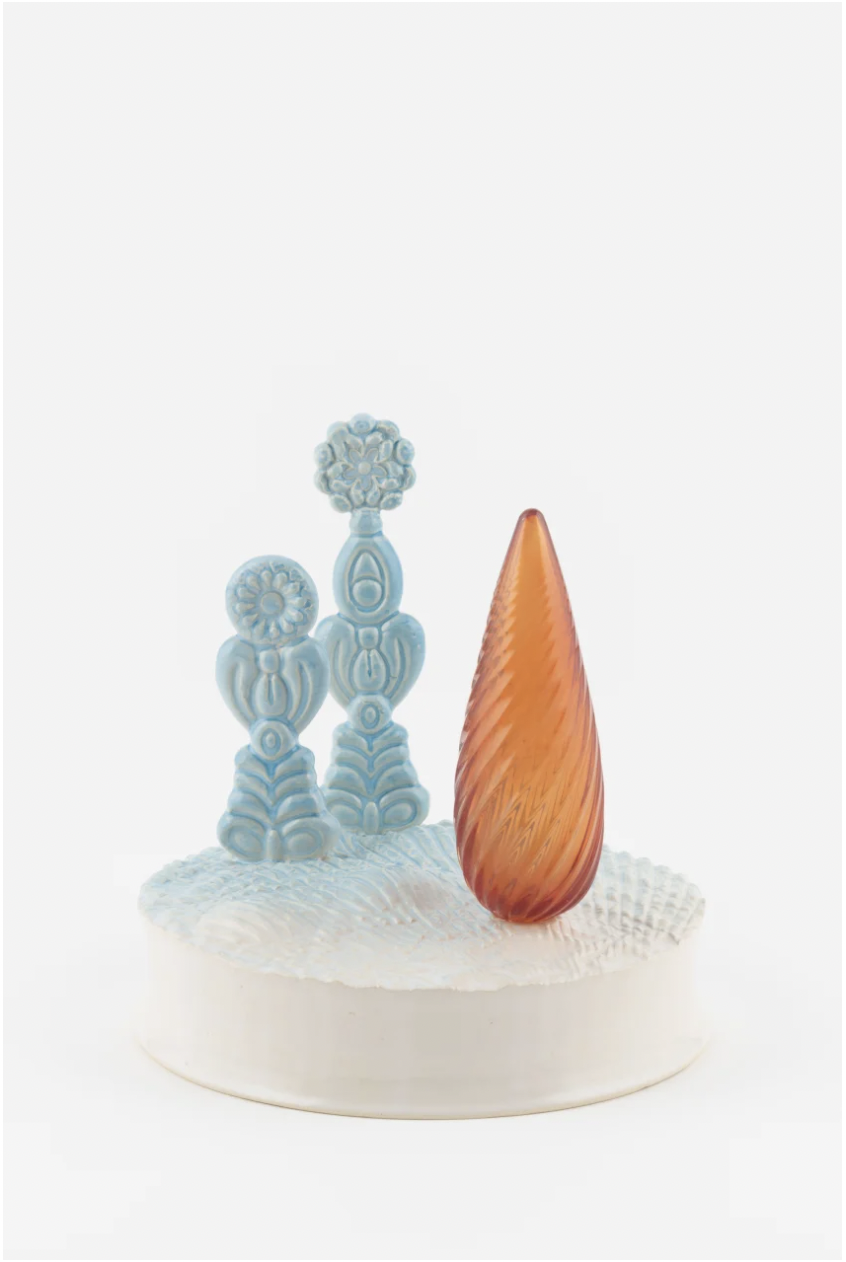Exploring the Dreamscape of "Sunlit Uplands": A Masterpiece Exhibition of Richard Slee Ceramics at Hales Gallery
For those unfamiliar with the wonderful and utopic work of Richard Slee, get ready to be mesmerised by the latest solo exhibition of one of Britain's most preeminent and highly-regarded ceramicists.
From January 21st to March 4th, 2023, Hales Gallery proudly presents "Sunlit Uplands", a showcase of Slee's latest works that will leave you breathless. With his incredible talent and meticulous attention to detail, Slee brings to life a world of whimsy, fantasy, and beauty through his intricate ceramic creations. Whether you're an art connoisseur or simply someone who appreciates beauty, this exhibition is not to be missed…
Installation view of Richard Slee “Sunlit Uplands”, Hales Gallery.
Slee is most known for the illuminating way in which he pushes the boundaries and traditional values associated with the field of ceramics by blending functional and creative elements, avoiding self-indulgence, and addressing contemporary issues through material specialisation in the visual arts.
His artistic roots can be traced back to the Constructivist art movement of the twentieth century, which emphasised modern industrial aesthetics in art. Yet, Slee does not follow the movement to the book. Instead, he pays homage to the industrial and ornate styles and infuses them with contemporary imagery and a touch of humour. The results are playful pieces that engage in a witty conversation between the familiar and the elaborate. For example, Slee's sculptures often feature exaggerated, bulbous shapes and bright, bold colours, such as in his 'Hammers', which take exaggerated styling and brightly coloured. In addition, Slee's non-functional ceramic works subtly reference the decorative purposefulness of ceramic pieces made during the Victorian period and the industrially-made promotional ceramics he draws from.
For this extensive project at Hayles Gallery, Slee delves into the concept of "sunlit uplands" to create a vivid dreamscape through his intricate miniature ceramic sculptures. With his interpretation of the "sunlit uplands" quote, Slee’s homecoming to the landscape is just the tip of the iceberg. The island is adorned with trees, sheaves of wheat, unicorns, and lions, giving it a cupcake-like appearance that is less nostalgic and more of an exhibition that offers a poignant and witty commentary on contemporary times. Through the repetition and variation of his sculptural scenes, the viewer is taken on a journey through a vast and diverse landscape with myriad scenic backdrops reminiscent of Gulliver's Travels. The artist presents a series of ceramic islands as symbols of a utopian paradise.
Close up installation view of Richard Slee “Sunlit Uplands”, Hales Gallery.
As a persistent innovator in the realm of British ceramics, Slee continuously pushes the boundaries and challenges conventional norms in the field. The works in this exhibition showcase his inspiration from wordless graphic novels and American newspaper comic strips. More specifically, he invests his imagination into an interplay of form, colour, and material to bring the scenes to life. When exhibited together, the effect is reminiscent of clear skies and radiant sunshine that creates a never-ending Arcadian atmosphere. This vision combines the ideals of a perfect world, where everything is in harmony and balance, with the captivating beauty of ceramic art. The effect is a dreamlike world that transports the viewer to a place of serenity and beauty, where nature and art come together in a perfect union. Consequently, this seemingly immersive experience allows for a deeper exploration and engagement with the intricate details of each scene.
In Uplands (28) (2021) Slee's use of glaze on the ceramic piece creates a reflective surface patina that dazzles under the gallery lights and produces a luminous effect reminiscent of a summer island with a sparkling sea which immediately attracts the eye. With their striking colours, the bold and vivid use of tropical botanical details taken from the rocaille enhances the piece's allure and this visual feast. Moreover, the addition of two unicorn heads positioned betwixt the twisted vegetal elements further evokes the work’s ethereal quality, creating a miniature fantasy scene for its spectators.
Moreover, in Uplands (210) (2021), the intricate balance between colours and materials imbue the work with grandeur and elegance, making it a true masterpiece of ceramic art. Choosing the complementary colour pairing of blue and orange, alongside contrasting opaque and transparent materials of ceramic and glass, is bold but brilliant. For another artist, this creative equilibrium could have easily been skewed, breaking the harmony present. However, Slee’s blend of textures, choice of colour gradients and tones and unique shapes hold the contrasts together and is a prime example of his unparalleled talent in crafting immaculate and super-lustrous ceramics.
Such a carefully crafted harmony is maintained in his horizontal and vertical works. Convolutions (16) (2021) and Rocaille (100) (2021) are perfect examples. Side-by-side, they are similar in terms of their colour palette, fluid lines and luminescent glaze finish. Yet, their connection is much more than that.
Convolutions (16) is like a wave that has been turned on its side and is about to crash into space. Rocaille (100) takes on the form of a rose that has been plucked from the bushes and, somehow, as if by magic, continues to flourish away from its original source. In essence, they animate the seemingly inanimate forms of nature and capture the essence of Slee’s intimate connection to his material.
Fundamentally, whether intentional or not, Slee’s work is not only a reflection of a symbol of the ‘ideal; but is also an effort to infuse wonder, joy, and humour into a society that has become desensitised.
Richard Slee's “Sunlit Uplands” will be on display at Hales Gallery until 4 March, 2023.
All images courtesy of Hales Gallery.
Shuchang Ke
Features Co-Editor, MADE IN BED









